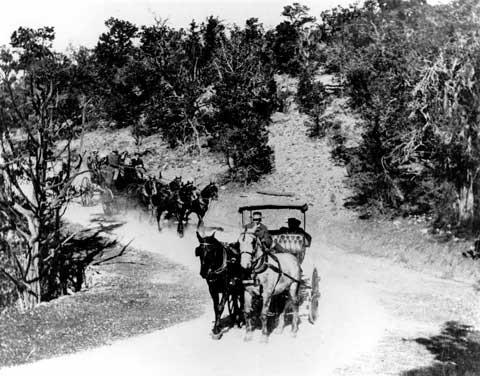As the accompanying photo shows, travelers at Grand Canyon National Park have been enjoying trips along a route known as the Hermit Road for nearly a century. A lot has changed since those rides in horse-drawn "touring coaches" began in 1911, and the road has recently reopened following a 9-month project that makes future travel both safer and a bit easier on the environment.
The historic Hermit Road, also known at times as the West Rim Drive, runs for seven miles between the South Rim Village and Hermits Rest, a traveler's way-stop built in 1914 by the Fred Harvey Company. The route's nine overlooks are popular spots for viewing the canyon, especially at sunset.
For many years, that popularity created serious traffic congestion as visitors vied for limited parking spaces at overlooks. Those problems were eased when the park began its free shuttle bus system in 1974, but the narrow road and lack of adequate trails along the route for pedestrians and bicyclists created on-going safety concerns.
The existing Hermit Road plus most of its associated overlooks were designed and constructed in 1934-1935, and the 18 to 20-foot-wide road was too narrow for safe bus passage, especially when bicyclists and pedestrians were also on the road. Time had also taken a toll on the pavement itself, which was in need of a major overhaul.
Earlier this month, the park held a ribbon-cutting ceremony to mark completion of a rehabilitation project that corrected those problems. The pavement is now a consistent width, improvements were made to shuttle bus stops at overlooks, and accessible pedestrian routes were added from shuttle stops to viewing areas.
Approximately five and a half miles of rim trails were improved, including construction of a new three-mile, multi-use Greenway Trail for bicyclists and pedestrians. Visitors who wish to enjoy the area by foot or bicycle now have a safe alternative to motorized travel.
Areas that had been damaged by informal trails and other impacts were also restored during the project. The Grand Canyon Trail Crew provided stone masonry and viewing area improvements at many of the viewpoints, more than 20,000 plants were added, and approximately 4 acres of native vegetation were restored at overlooks and along the length of the road.
Private vehicles will be allowed to use the Hermit Road until March 1st, when shuttle bus service will resume until the end of November. During those months of peak visitation, the road is closed to private vehicles.
This year also marked completion of modernization of Grand Canyon’s shuttle bus fleet, which operates on the Hermit Road and other routes on the South Rim. The park's entire visitor transportation system is now wheelchair accessible, and all of the buses are now powered by compressed natural gas (CNG). The replacement of the park’s older diesel buses with CNG powered units will improve the visitor experience by substantially reducing air pollutants and noise levels.
Reducing air pollution and noise from vehicles will make it easier for all visitors to the park to enjoy those famous canyon sunsets.




Add comment